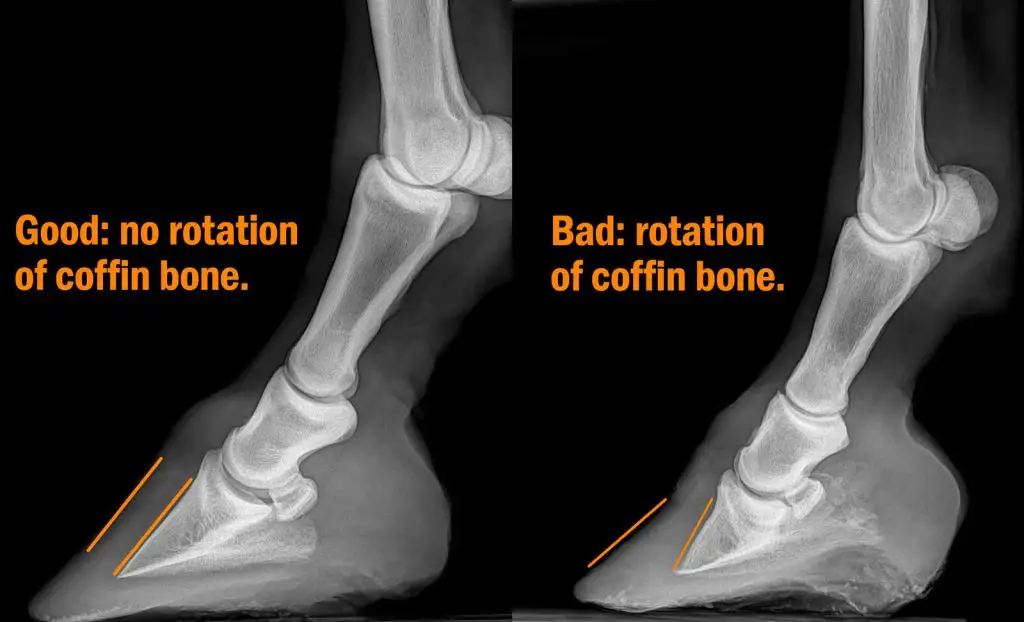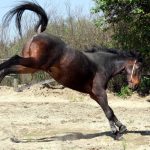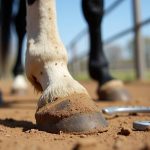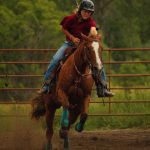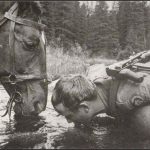How Quickly Can a Horse Founder on Grass? Horse founder is a severe weight-bearing lameness caused by the inflammation of the laminae which connects the pedal bone to the hoof wall. Grass can cause horses to founder quickly if they are allowed unrestricted access to it. This is especially true for horses that have been kept on dry or limited hay diets and then suddenly given free access to lush, abundant grass in springtime.
In addition, some horses may be prone to laminitis due simply to their own metabolic issues such as Cushing’s syndrome, or because of their breed predispositions (i.e., ponies). These animals must be closely monitored with respect to their diet even when only grazing on grass and should not be allowed extended periods of time out in pastures with abundant grasses available.
Foundering is a common issue in horses that are kept on lush grass pastures, as the high sugar levels and moisture content of the grass can cause them to founder quickly. As such, it’s important for horse owners to be aware of this risk and take steps to reduce their horse’s exposure to these types of pastures or put measures in place for proper grazing management. This includes limiting access times, rotating paddocks regularly, maintaining healthy soil conditions with regular fertilizing and liming treatments, as well as other practices that will help keep your horses safe from an episode of foundering.
When is Grass Most Dangerous for Horses
Grass can be most dangerous for horses to graze on during periods of rapid growth, such as after heavy rain or the application of fertilizer. During these times, grass can contain high levels of sugar and other nutrients which can cause digestive problems in horses if they eat too much. Additionally, ingesting large amounts of lush grass can lead to laminitis, an often painful and serious hoof condition caused by inflammation of the sensitive tissues inside a horse’s hooves.
Therefore it is important that owners monitor their pastures carefully and restrict grazing when necessary.

Can a Horse Get Foundered on Grass?
Yes, a horse can get foundered on grass. Foundering, also known as laminitis, is an inflammation of the laminae in the hoof that causes severe pain and lameness. Though it is often associated with overconsumption of grain or other high-starch feedstuff, horses can also founder on grass if they are not managed properly.
Grass contains sugars that increase quickly when exposed to warm temperatures and drought-like conditions. Rapidly growing pasture grasses are especially dangerous because they contain large amounts of sugar which can cause rapid weight gain in horses if left unchecked. Additionally, some horses may be sensitive to certain types of forage such as fescue or ryegrass which can further exacerbate the condition if eaten in excess or for prolonged periods without rest days.
Proper management is essential for preventing foundering due to grazing; this includes providing plenty of turnout time but reducing access during peak growing hours in summer months and supplementing with hay during times when pasture availability is low.
How Do You Keep Horses from Foundering on Grass?
Foundering in horses is a common issue that can be caused by overfeeding, lack of exercise, or the horse consuming too much grass. To prevent foundering on grass, it is important to monitor your horse’s nutrition and make sure they are getting adequate amounts of minerals and vitamins. Feeding hay instead of grazing can also help reduce the amount of sugar consumed from grass.
Additionally, you should limit the time your horse spends grazing on lush pastures as this increases their risk for foundering due to an abundance of high-sugar feeds available from plants like clover and fescue. Exercise plays an important role in managing foundering since regular activity helps maintain healthy muscle mass which keeps insulin levels in balance. Finally, making sure your horse gets regular hoof care such as trimming and shoeing will help keep them balanced and able to move more freely which reduces their chances of developing laminitis or other foot-related issues associated with foundering.
How Can You Tell If a Horse Is Foundering?
Foundering is a common condition that affects horses, and it’s important to know how to tell if your horse might be suffering from it. One of the most obvious signs of foundering is lameness, which can range from mild discomfort or tenderness in the hooves to an inability to bear weight on all four feet. Other warning signs include increased sensitivity when pressure is applied directly over the sole area or heel of the hoof, heat radiating from each foot, and excessive moisture around the coronary band.
Your horse may also exhibit a decreased appetite, lethargy, or depression when dealing with this condition. If you suspect your horse might have to founder, contact your veterinarian right away for diagnosis and treatment plans; left untreated it can lead to more serious complications like laminitis and founder abscesses.
How Fast Can a Horse Get Laminitis?
Laminitis is a serious and potentially life-threatening condition in horses, caused by inflammation of the sensitive laminae that support their hooves. It can be brought on by many different causes such as overfeeding, injury to the foot or leg, retained placenta after foaling, or simply from changes in weather. The speed with which a horse may develop laminitis varies depending upon its particular circumstances; however, it can occur very quickly and without warning.
In some cases where there has been an abrupt change in diet or exercise regime, for example, symptoms may begin to show within hours of exposure to the trigger factor. In other scenarios such as following colic surgery or if there are imbalances in blood sugar levels due to insulin resistance for instance then signs of developing laminitis can become apparent in just days. Prompt diagnosis and treatment are essential though as otherwise permanent damage could occur leaving long-term effects on both health and performance capabilities even when clinical signs have disappeared.
Equine nutrition (including grass founder)
Conclusion
Overall, it is clear that grass founder can easily occur in horses and should be monitored closely. If a horse has been exposed to lush pastures, signs of laminitis must be watched carefully. While many factors such as genetics, diet, and exercise level can contribute to the development of this condition, limiting access to pasture is one important way to help reduce its occurrence.
In addition, seeking professional advice from a veterinarian at the first sign of laminitis can ensure early detection and treatment which will go a long way in helping prevent further damage from occurring.
Janet G Kulick is an experienced horse rider, trainer, and owner of the informative horse blog, Horseray.com. Her engaging writing style and wealth of knowledge on horse care, riding, and training make her a trusted source for horse enthusiasts worldwide.

